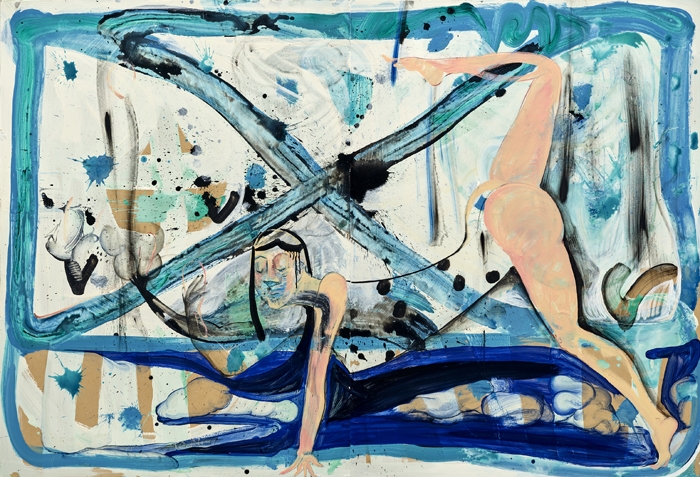A few years ago, suffering a loss of hearing and having exhausted all conventional treatments, Taiwanese artist Tang Jo-Hung consulted mediums to treat his condition. The experience subsequently inspired a series of paintings called Fairy, for which he won the First Prize at the Taipei Arts Awards in 2016. The paintings are pastiches of religious imagery, combining human subjects and a private symbology: a naked Jesus in boots, a priestess with fat lips blowing smoke and a Chinese deitylike figure riding a giant fish. While not easily read, the paintings’ immediacy – fearless brushstrokes and seductive hues – suggests the urgent transcription of divine visions. But things are not quite as they seem. The fish-riding immortal, for example, has the knot of a necktie peeking out from under the collar of his magisterial robes. A costumed medium? A salaryman attaining sainthood? In his introduction to the exhibition, Tang says he doesn’t believe in the spirits and gods of religion or folklore. ‘They only exist in a world where I fantasise that I believe in gods and I am occasionally devout.’ That might explain the enigmatic quality in these works: half-exalting, half-satirical.
His Fairy series, as well as 41 other paintings, mostly from the past five years, are included in this survey. Tang’s style is predominantly influenced by Western modernisms, Edvard Munch-esque Continental expressionism and the gestural vigour of Abstract Expressionists such as Willem de Kooning. He also owes a debt to Pablo Picasso (Tang completed his art studies in Spain), in the fractured Cubist surfaces that blend portrait and landscape (White Old Guy. Star. Countless Mountains, 2019). Blue and Rose Period harlequins are recast into new archetypes, such as a man-child in a pointy hat being piggybacked by an older man (Set off. Go Down a Hill. The Elderly Piggybacks the Youth, 2019).
His subjects, meanwhile, draw from a variety of references: everyday life (The Goddess in Downward-Facing Dog is Looking in the Mirror at Herself, 2019), theatre (Holding up the Hat While Running in a Stage Play, 2018) and some commingling of the two (Waiter on Roller Skates, 2018). There’s also Napoleon blowing a trumpet (Napoleon Must Win, 2019) and Faust with three arms (Fausto, 2019).
Most of the scenes are staged in a timeless nowhereland of the artist’s imagination; not all of them are immediately intelligible. Others are generic portraits of Westernised human figures, rootless, which could have come from anywhere. The work is more compelling when it draws explicitly from personal experience, such as the Old Man series – a midlife crisis described on canvas – which, the artist says, was the result of him hitting forty-five.
A caustic sensibility informs Seek Divine Guidance (2019), which reflects on the search for magical cures. A slender, elongated man kneels in front of a little vase emitting smoke, gazing at a tendril of mist with salacious wonder. His body is thin and hungry, and his neck cranes forward like a turtle. During seances, Tang seems to say, the spirit being consulted may not be the most frightening creature in the room. The desperado is.
Tang Jo-Hung: Old Man. Fairy. and a Bit of Everything at Taipei Fine Arts Museum, Taipei 17 August – 10 November
From the Winter 2019 issue of ArtReview Asia
